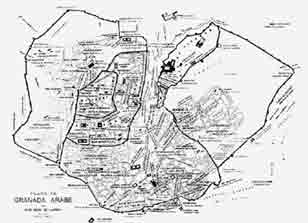 |
[ZAWiW] [gemeinsamlernen] [LiLL] | ||
|
Page 1 of 7
|
||
| home | ||
|
|
Answer from Granada | |
|
|
A Brief History of Granada | |
|
|
Gallery: Granada of Past and Present | |
 |
||
Answer from Granada
Stand:Answers by the Granada Group (Spain) to the Questions of the Lyon Group (France)
>>alternatively download answers as PDF-document here
1. HAS THERE BEEN A PROGRAMME OF HOUSE RENOVATION IN A HISTORICAL PART OF GRANADA?
. |
Yes, in the ALBAICIN |
Situation
This suburb is situated on the western foothills of the Cerro of San Miguel, on the right side of the river Darro, and opposite the hill of the Alhambra. Plan of the Albaicín
Plan of the Albaicín
History.
If, until the end of the XIVth century, the term Albayzín referred exclusively to the suburb to the north of the Alcazaba Qadima, from the XVth century onwards the term has been applied to the mediaeval parts of the city: Alcazaba Qadima - the oldest-, Axares, Zenete and the Albayzín.
The origin of the term Albayzín is much disputed; for some it alludes to the inhabitants: the Spanish muslims who, coming from Baeza, occupied the area after the fall of their city into the hands of the Christians in 1227; for others, the term comes from Rabad-al-Bayyazín, which means suburb of the falconers, or suburb on a hill or on a slope.
However, there is no doubt that the site is the origin of the city of Granada, its oldest area of human settlement, as has been revealed by the archaeological digs at the side of the Arab walls of the XIth century, revealing part of the Iberian and Roman walls, as well as remnants of these two cultures. The remnant of the Iberian wall here, of irregular blocks of stone, is considered to be the oldest monument in Granada, dating from the beginning of the third century before Christ.
About the middle of the eighth century, the area was populated by Arabs. The construction of the first fortress, which was later to receive the name Alcazaba Qadima o Vieja, was attributed to the governor of Elvira, (the Arab name for the area) Asad Ben Abd al Rahman al-Xaybani.
The fortress was almost completely dismantled, owing to the struggles in the second half of the ninth century, between Arabs, Mozarabs and Muladies, only being consolidated with the arrival of the Zirí dynasty in the eleventh century.
The alcazaba Qadima was the centre of political power until the twelfth century, when the founder of the Nazarí dynasty, Alhamar, decided to move his seat to the Alhambra hill. Despite the move of the court, the area continued to be very important economically, enjoying political and administrative independence, and becoming, in the fourteenth century an important and powerful area within the kingdom of the Nazarí, and a centre of continual revolts against the ruling power.
 Here are plans of the Arab City of Granada
Here are plans of the Arab City of Granada
Demographically very dense, its inhabitants were artisans, manufacturers and aristocrats, who, despite the move of the court continued to live there.
The change in the importance of the suburb was produced after the Christian conquest of the area, in 1492. Living conditions got worse and worse, with the increase in taxes, the prohibition of buying land in the fertile valleys outside the city proper, and the aggressive politics of Cardinal Cisneros. All of these factors combined to produce many uprisings, and the beginning of acculturalisation and repression, building churches on land left by demolishing mosques, and the enforcement of the Inquisition.
From the reign of Felipe II - the second half of the sixteenth century -, with the rebellion of the Arabs (1568-1570) and their consequent expulsion, the area was progressively abandoned, and a period of decadence began, which was even more pronounced in the twentieth century- after a short period of restoration by the Romantics- in which demolition, speculation and immigration became the bases for the deterioration of the area.
Activities:
In recent years there has been great interest shown by the relevant authorities in trying to re-establish the features of the area, declared to be Patrimony of Humanity by UNESCO on December 15, 1994.
The importance of the historical area lies in its cultural value; illustrated in its undoubted capacity to evoke and interpret the past, and as a support of creative activities in the present and the future.
Today, the chief problems of the area lie: in arresting both its progressive abandonment and the losses of items of patrimonial value; in the establishment and increase of a fixed population; and in the allocation of urban functions which will contribute to the area becoming a valuable and vital part of the city.
The city council, aware of the existing possibilities, has initiated several programmes for the revitalisation of the historical part of the city, particularly the Albaicín. These are:
